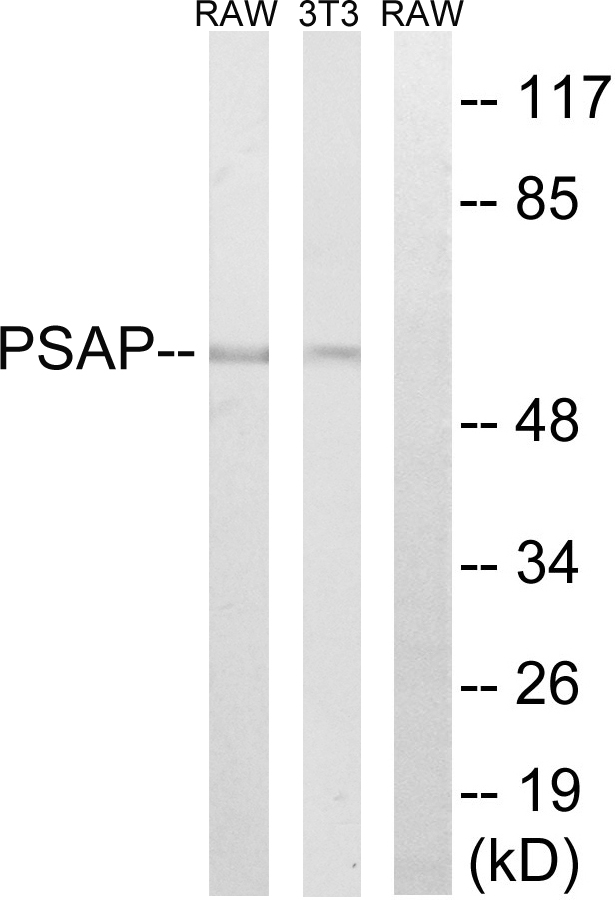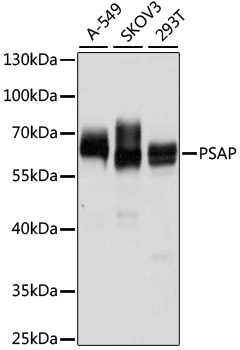PSAP antibody [N1N3]
GTX101064
ApplicationsWestern Blot, ImmunoHistoChemistry, ImmunoHistoChemistry Frozen, ImmunoHistoChemistry Paraffin
Product group Antibodies
TargetPSAP
Overview
- SupplierGeneTex
- Product NamePSAP antibody [N1N3]
- Delivery Days Customer9
- Application Supplier NoteWB: 1:500-1:3000. IHC-P: 1:100-1:1000. *Optimal dilutions/concentrations should be determined by the researcher.Not tested in other applications.
- ApplicationsWestern Blot, ImmunoHistoChemistry, ImmunoHistoChemistry Frozen, ImmunoHistoChemistry Paraffin
- CertificationResearch Use Only
- ClonalityPolyclonal
- Concentration1.98 mg/ml
- ConjugateUnconjugated
- Gene ID5660
- Target namePSAP
- Target descriptionprosaposin
- Target synonymsGLBA, PARK24, PSAPD, SAP1, SAP2, prosaposin, precursor of saposins, proactivator polypeptide, saposin-A, saposin-B, saposin-C, saposin-D, sphingolipid activator protein-1, sphingolipid activator protein-2
- HostRabbit
- IsotypeIgG
- Protein IDP07602
- Protein NameProsaposin
- Scientific DescriptionThis gene encodes a highly conserved glycoprotein which is a precursor for 4 cleavage products: saposins A, B, C, and D. Each domain of the precursor protein is approximately 80 amino acid residues long with nearly identical placement of cysteine residues and glycosylation sites. Saposins A-D localize primarily to the lysosomal compartment where they facilitate the catabolism of glycosphingolipids with short oligosaccharide groups. The precursor protein exists both as a secretory protein and as an integral membrane protein and has neurotrophic activities. Mutations in this gene have been associated with Gaucher disease, Tay-Sachs disease, and metachromatic leukodystrophy. Alternative splicing results in multiple transcript variants encoding different isoforms. [provided by RefSeq]
- Storage Instruction-20°C or -80°C,2°C to 8°C
- UNSPSC12352203
References
- Fuyuki A, Yamamoto S, Sohel MSH, et al. Expression of prosaposin and its G protein-coupled receptor (GPR) 37 in mouse cochlear and vestibular nuclei. J Vet Med Sci. 2023,85(3):266-270. doi: 10.1292/jvms.22-0552Read this paper
- Chiu CC, Lu CS, Weng YH, et al. PARK14 (D331Y) PLA2G6 Causes Early-Onset Degeneration of Substantia Nigra Dopaminergic Neurons by Inducing Mitochondrial Dysfunction, ER Stress, Mitophagy Impairment and Transcriptional Dysregulation in a Knockin Mouse Model. Mol Neurobiol. 2019,56(6):3835-3853. doi: 10.1007/s12035-018-1118-5Read this paper
- Marceau CD, Puschnik AS, Majzoub K, et al. Genetic dissection of Flaviviridae host factors through genome-scale CRISPR screens. Nature. 2016,535(7610):159-63.Read this paper
- Lai MC, Chang CM, Sun HS. Hypoxia Induces Autophagy through Translational Up-Regulation of Lysosomal Proteins in Human Colon Cancer Cells. PLoS One. 2016,11(4):e0153627. doi: 10.1371/journal.pone.0153627Read this paper





![ELISA analysis of antigen using GTX60673 PSAP antibody [4D5F4]. Black : Control antigen 100ng Purple : Antigen 10ng Blue : Antigen 50ng Red : Antigen 100ng](https://www.genetex.com/upload/website/prouct_img/normal/GTX60673/GTX60673_20170912_ELISA_w_23061123_620.webp)
